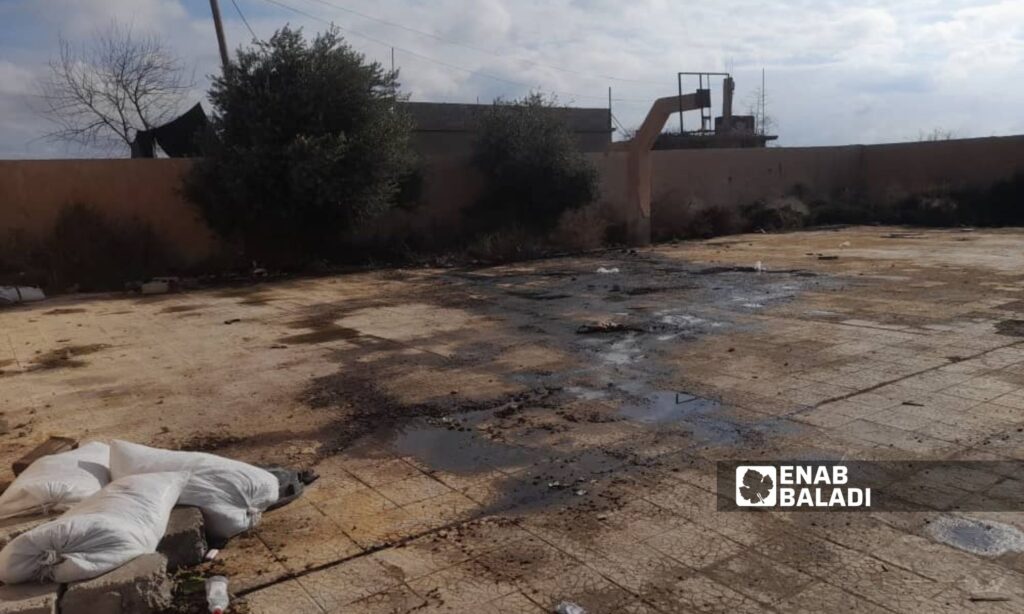The Syrian Democratic Forces (SDF) have evacuated the Hawi al-Hawayej school, which they had previously used as a military headquarters in eastern Deir Ezzor province.
Enab Baladi‘s correspondent in Deir Ezzor reported that the SDF’s withdrawal from the school took place on March 8, without clear reasons.
After the withdrawal, the forces handed over the school to the educational complex in the area, while the educational complex is working to reclaim other schools that are still being used as military points in the same region.
Photos taken inside the school by Enab Baladi’s correspondent following the soldiers’ withdrawal show the infrastructure’s destruction after being used as a military point for SDF for months.
Damage to a school in eastern Deir Ezzor after being turned into a military point by SDF – March 10, 2024 (Enab Baladi/Obadah al-Sheikh)
Other schools
Enab Baladi contacted an educational supervisor and administrator of the Euphrates educational complex in eastern Deir Ezzor, who wished to remain anonymous for security concerns. He said that SDF had also evacuated two schools in the town of Abu Hamam, and three others remain in use as military points.
He added that four schools in the town of al-Shanan in the east of the province had been evacuated of military forces, in addition to two schools in the town of al-Tayana, with one school there still being used as a military point.
The educational supervisor said that around 20 schools in the rural areas of Deir Ezzor are still being used as military headquarters, with plans to hand them over to educational complexes at a later time.
In turn, journalist Ibrahim al-Hussein, director of the local website “Alsharqia Post” for Enab Baladi, said that SDF has converted many schools in the rural areas of Deir Ezzor into military headquarters and threatened students who demanded the evacuation of the schools, as happened during demonstrations by people and students of Abu Hamam school in the countryside of Deir Ezzor at the end of last year.
21 Civil facilities converted to military points
In September 2023, coinciding with security tensions in the area following the arrest of the leader of the Deir Ezzor Military Council affiliated with the SDF, Ahmad al-Khabil, the Syrian Network for Human Rights (SNHR) reported that 21 service facilities had been converted into military points in Deir Ezzor.
According to the SNHR, this included 18 schools, a single medical facility in northern Deir Ezzor province since August 29, 2023, and the facilities were spread between the villages of Eastern Khabur and Western Khabur in the northern countryside of Deir Ezzor province.
Early this year, the SDF converted water stations into military points in the eastern rural areas of Deir Ezzor and restricted the entry of employees and workers to specific hours, causing a water shortfall for civilians’ homes.
Enab Baladi’s correspondent in eastern Deir Ezzor documented the presence of military fortifications at some water stations on the banks of the Euphrates River in the region, coinciding with a decline in the water supply rate to residential neighborhoods in villages and towns of the area since December 2023.
Among the stations where military fortifications were observed on their roofs are al-Subha and Abreiha, in addition to water treatment stations in al-Basira and al-Shuhail, and the towns of Dhiban, al-Jardi al-Sharqi, al-Sousa, al-Bu Badran, and al-Sha’fah.
A classroom at Hawi al-Hawayej school in eastern Deir Ezzor after the withdrawal of the SDF from it – March 10, 2024 (Enab Baladi/Obadah al-Sheikh)
Escalation disrupted the education sector
In September 2023, with students in northeastern Syria beginning to flock for the start of a new school year, the opening of schools in the eastern countryside of Deir Ezzor was delayed due to security tensions and armed conflicts, the echoes of which still reverberate in parts of eastern Syria to this day.
Amidst the armed confrontations between local fighters from Deir Ezzor’s tribes and the SDF, most services were cut off from the area.
The children of the region experienced interruptions in their schooling since the announcement of the schools’ opening during the peak of the military confrontations between the parties.
In a previous conversation with Enab Baladi, a responsible source in the Teachers’ Union affiliated with the Autonomous Administration in the countryside of Deir Ezzor said that school attendance is facing “major challenges,” the most significant being the weak turnout for attending schools due to parents’ fears of the security tensions in the region, especially in recent times.
The region suffers from a shortage of teaching staff; the Autonomous Administration regularly announces competitions to appoint new teachers, but the educational staff remains insufficient for the region’s needs.
The leader of the SDF, Mazloum Abdi, pledged after the confrontations ended to fulfill the demands of the eastern Syrian Arab tribes and rectify the “mistakes” he said were made in managing the region in an effort to defuse tensions after days of fighting witnessed in Deir Ezzor.
Regarding how to fix the “defects,” Abdi promised to restructure both the Civil Council affiliated with the Autonomous Administration that governs the province, alongside the Deir Ezzor Military Council affiliated with the SDF, to make them more “representative of all the tribes and communities in Deir Ezzor.”
On August 28th last year, armed confrontations broke out in the rural areas of Deir Ezzor following the arrest of the SDF’s Military Council leader, Ahmad al-Khabil (known as Abu Khawla), which led to an alliance of tribes in the area with the Council fighters, and military clashes began that were described as “violent” in some villages and towns of Deir Ezzor, which slipped entirely out of the SDF control, and then the SDF managed to contain the tension in them.
Enab Baladi’s correspondent in Deir Ezzor, Obadah al-Sheikh, contributed to this report.

